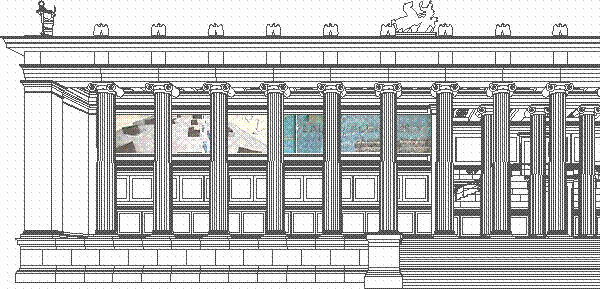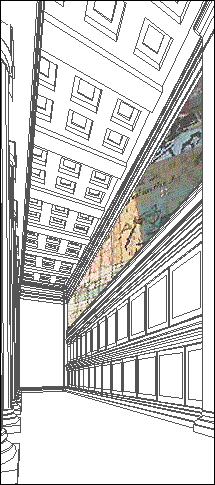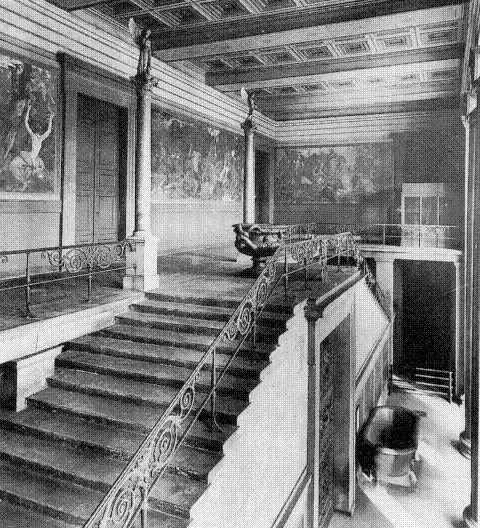1996.08.03
Stirling interpretations
I have decided on a document centering on James Stirling's three masterful interpretations: the Stirling/Corbu Olivetti projects, the Düsseldorf / Altes Museum connection, and the Cologne [Wallraf-Richartz Museum] promenade architecturale. This will be a very full document featuring four virtual buildings (Düsseldorf, Cologne, Stirling Olivetti, Corbu Olivetti). Schinkel's Altes Museum and the Corbu architectural promenade buildings will be featured but not documented.
The secondary point of the document is to exhibit a largely undisclosed circle of design influence and intentions between Schinkel, Le Corbusier, and Stirling. I have already thought out the specific connections between Stirling and Corbu and Stirling and Schinkel, but I will also be introducing a possible Corbu-Schinkel connection in the "architectural promenade" of the Altes Museum. Although this circle of three architects is important, the main point will be to demonstrate the methodology of Stirling's art of architectural interpretation.
The three discussions of the three Stirling projects bring up Stirling's submission to Roma Interrotta and I will be using that "design" as an other example of a Virtual Museum of Architecture and as yet another example of Stirling's fine art of interpretation and reinterpretation.
The document will end with a discussion of how the circulation sequence of the Altes Museum is very similar to the Corbusian architectural promenade formula... I also have to mention how Boullée inspired the Altes Museum, and this then brings up the French/German crossover -- cross fertilization. [...and there is more in the notes.]
1997.06.11
ideas
2. ...beginning to wonder whether architecture in the virtual realm is more the product of the osmotic imagination.
3. ...add spaces within the "framework" of the Piranesi plans.
1998.04.03
B. F. Parkway: An Interpolation
...the Parkway as virtual space from its very inception.
1998.06.05
virtual place
It is perhaps the pervasive archival and repository nature of virtual place that manifests an advantage over real place. It could be described as an historian's dream come true in that all transactions and data creation and transmittals are recorded in time. Time and its immediate connection to action is one of the especial features of virtual place in cyberspace.
| |
|
The back wall [of the Lustgarten facade of the Altes Museum] is to be decorated with frescos bearing some relation to the purpose of the building. Those paintings, seen through the columns, are intended to lend serenity to the building.
Karl Friedrich Schinkel
With time the rear wall of the hall can be decorated with a row of murals, perhaps with a cycle of pictures from the evolutionary history of mankind, which would be a worthy challange for the most important talents Your Majesty would feel worthy of such a commission.
Karl Friedrich Schinkel
...among [Schinkel's] figure paintings is the series of sketches he made between 1828 and 1834 for the fresco decorations to the vestibule of the Museum am Lustgarten, built between 1823 and 1830. The frescos were not executed until after Schinkel's death, and they were very largely destroyed in 1945. Echoing the famous Stoa Poikile in Athens, they were meant to be visible to everyone from outside and to set the contents of the building -- antique sculpture and modern paintings -- in the context of the whole cosmos.
Helmut Börsch-Supan
The question still remains whether cyberspace can sucessfully inform real world architecture. To this end I propose a "cyber" project for the real world to consider:
Schinkel's Altes Museum in Berlin originally had two long murals within its colonnaded porch; they were destroyed at the end of WWII and not restored. The murals depicted an allegorical history of civilization, and I now propose a "hyper" restoration of the mural. As such, the new "hypermural" can depict "civilization" as it actually occurs, along with depicting any numbers of other images either static or moving.
Stephen Lauf
e-mail to Marcus Ormerod and Merlyna Lim, 4 August 1998
| |

Altes Museum, original rendition of Lustgarten elevation, K. F. Schinkel, 1822
|

 
Stephen Lauf, Hypermural for the Altes Museum (Berlin: www.quondam.com, 1998.08.23), partial view of front elevation.
| |

|




